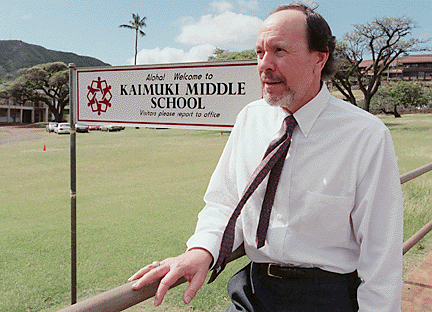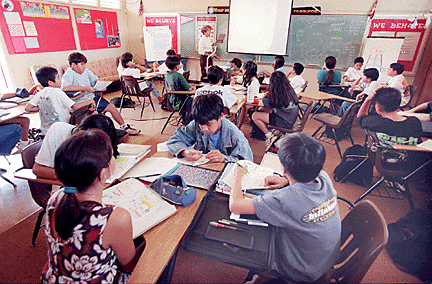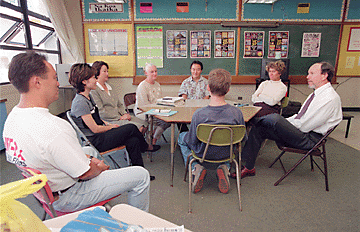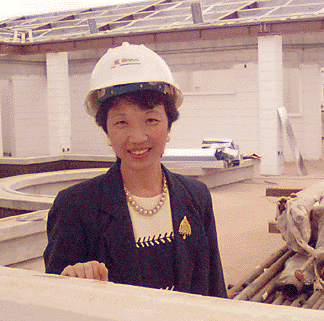


Traditional intermediate schools
By Crystal Kua
are giving way to a reform
movement that is changing the
way young adolescents are
educated in Hawaii
Star-Bulletin
When Frank Fernandes attended intermediate school, the school's focus was strictly academics -- adolescent pangs were left to the family and others."If I had problem, there was no classroom time to take care of that problem," Fernandes said. "A lot of social and emotional needs were being met by the family and a range of organizations."
But with broken homes, both parents working and other societal changes of today, schools must also provide support to students to foster academic growth.

"More of those needs have to be filled in schools," Fernandes said. "We have to take care of them to promote learning."As a result, more intermediate schools are becoming middle schools as part a reform aimed at changing the way young adolescents are educated in Hawaii.
"It is a groundswell. The movement is just booming," said Paul Deering, a University of Hawaii associate professor of education with expertise on middle schools.
"It's really catching on statewide," said Fernandes, principal at Kaimuki Middle School.
Deering said virtually every school with early adolescents in Hawaii is either examining the middle school approach or implementing some form of it.
What's the difference between an intermediate school and a middle school?
Plenty, say Deering, Fernandes and others involved in the middle school movement in Hawaii.
Traditional intermediate schools are seen as individualized and isolated, while the middle school concept promotes a collaborative attentiveness to the whole student, proponents say.
Every facet of human functioning goes haywire for early adolescents, ages 10 to 15, Deering said.
"This age group undergoes the greatest array of changes in the entire human life span other than from birth to age 2," Deering said. "With all this stuff going on, academics become a tremendous challenge for kids."
Intermediate schools, which are also called junior high schools, are just that -- a junior version of high school.
"You get your schedule, wander around, and survive," Deering said. "Nobody can be a good student if they're worried about being beat up or worried about their next class. ... So given all the changes and the other demands, you can hardly do worse than a typical intermediate school."
The middle school philosophy addresses the physical, social and emotional needs of these ages in order to open up the student to learning, experts said.
Fernandes, whose school recently received a national award, said the key to the middle school philosophy is understanding the link between academics and the student's psyche at this age.
Its beginnings here
The middle school movement in Hawaii began about 10 years ago with momentum provided by a group of Honolulu intermediate school principals who noticed common problems and themes at their schools, said Fernandes, who was one of those principals.Grades were dropping, with more students receiving F's and D's, test scores tended to dip at the midlevel grades, students focused more on their peer groups, and school climate was deteriorating.
With support from the district office, the schools began to embrace the middle school philosophy. Changes in organization and curriculum proceeded slowly.
Fernandes said at his school, grades have begun to climb, test scores are getting better and school climate has improved, with a more respectful atmosphere.

Deering said there is no single definition of what constitutes a middle school. "It's understanding the age group and constructing the schools and classes accordingly.""Good middle-level schools ... make learning very active, very hands on and most important they provide a highly personalized school environment," Deering said.
An important element is team teaching, where a small group of teachers is assigned to a common pool of kids. "They take care of those kids. They watch over them," said Deering, who taught for nine years in middle schools in Ohio.
Interdisciplinary teaching -- linking subjects together in a common framework -- is also seen in these schools. For example, the study of volcanoes can have components in math, science, social studies, English, art and music.
Another important element is providing students with guidance or advisory time to get to know each other and to learn social skills, how to deal with conflict, coping skills and other issues related to this age group.
"You give them a little extra TLC," Deering said. "These kids know they can come to me. I may not solve the problems but I can help."
Organizational changes -- moving sixth-graders with seventh- and eighth-graders -- are also seen. "Sixth-graders can identify more with their older counterparts than their younger counterparts," Fernandes said.
Improvement nationally
Nationwide, the middle school concept is showing positive results.Research published in the education journal Phi Delta Kappan compared schools that fully implemented middle school concepts with schools that had some or none of the concepts in place.
The research showed that adolescents in schools with fully implemented middle school concepts had better test scores in math, language and reading than students in schools that had some or none of the concepts in place.
The research also showed students in fully implemented middle schools are less fearful of being victimized, are less worried about something bad happening at school and in the future, and have higher self-esteem. Teachers in these schools report fewer student behavioral problems.
Parent Laura Brown, president of the Mililani School Complex PTSA, said she thinks the middle school concept "could be misapplied due to a lack of funding."
Brown said she and other parents are not sold on the middle school concept because it appears to focus too much on self-esteem and not enough on academics, especially for students on an advanced, college-bound track who need to take certain kinds of courses.
"It's kind of touchy-feely," Brown said. "It's a nice idea, but I don't think it really works."
How Kaimuki does it
By Crystal Kua
Star-BulletinEighth-graders Cecily Goo and Jennifer Nagamine calculated their ethnic backgrounds in a math lessons on fractions. They researched their family trees in social studies and read short stories from other lands in English class.
In exploring other cultures, these Kaimuki Middle School students learned reading, 'riting and 'rithmetic as well as something about themselves.
It's this attention to student nurturing that won praise from national education observers -- who called the school "vibrant" -- and led to Kaimuki Middle School being named a 1997-98 National Blue Ribbon School, one of 166 secondary schools in the nation to receive this honor.
Kaimuki Middle School, whose motto is "A place with heart that challenges and strengthens mind, body and spirit," is the epitome of the middle school concept.
Students and teachers are organized in teams, and interdisciplinary teaching, a style normally seen in elementary schools where subjects are linked by a common thread, is at the center of learning.
Math specialist Deede Santiago, health/science teacher Alan Sakoguchi, art teacher Carol Hamada, social studies/literature teacher Alexis Kane, and social studies teacher Sandra Afuso gather daily to plan their strategy for sixth-graders.
They teach their subjects through cultures. Topics such as Chinese kites, rockets and sumo wrestling involve their disciplines.
"It's kind of looking at what fits best where," said Santiago, the team leader.
Another important component the school added recently was an advisory program.
"We felt that guidance was just as important as language arts and social studies," said counselor Mike Kawamoto, also a member of the sixth-grade teaching team.
Santiago said the advisory program was necessary to pull all the middle school concepts together. "We saw the kids needed time to talk about things that really concerned them."
The goal in exploring the nonacademic interests of students is to help them with their academics.
Seventh-grader Jennifer Kim went with classmates on an outing that included a stop at the Ice Palace. "We got to know each other better. We can get to know other people," she said.
Forging relationships provides support in the classroom. "Having students around you to help you is better ... In class, if the teacher is busy, I go to my friend and he or she helps me," Kim said.
Seventh-grader Fayez Rumi felt that team learning sometimes overshadows individual expression. "The teacher decides everything," he said.
But Rumi fills the void with an elective media class.
Principal Frank Fernandes credited the strong emphasis on teaching with making the school a winner. "There is no successful school without successful teachers," he said. But the Blue Ribbon observers noted that Fernandes' "clear vision" is at the core of the school's progress.
The teachers said the Blue Ribbon process was a time of self-examination for the entire school and the award recognizes a school full of hard-working folks.
"It's nice that some people took notice," Kane said.

Kapolei Middle School
By Crystal Kua
evolved from a vision
Star-BulletinAnnette Nishikawa compares her role as the newly selected principal of the still-being-constructed Kapolei Middle School to that of an expectant mother.
"It's like giving birth to a new child," she said.
For Kapolei Middle School, this birth evolved from ideas spawned by education officials, teachers, parents, students, business and community groups, carrying the school's philosophy all the way through to the movable walls and the eight-sided cafeteria.
Construction, a cooperation between the public and private sectors, is proceeding on schedule, with classes slated to begin in July on a year-round schedule.
The school will open with 922 students but has the capacity to handle between 1,200 and 1,600.
It's a school created to embody the middle school philosophy -- educating adolescents by paying attention to their needs -- from the brainstorming design sessions to the hiring of teachers.
Kapolei Middle will weave technology, culture and the arts into its subjects and is already part of the design of its buildings.
The school features:
An octagon-shaped cafeteria, which is part of a larger cultural center that will be used for dining, entertainment and multiple purposes. The eight-sided design offers a space for serving food, a stage for performances and different doors for traveling to various parts of the campus, including an amphitheater outside the cafeteria.
Classroom buildings are called "houses" to reflect family-
style learning and promote interdisciplinary teaching. Each "house" has a "porch" and a courtyard where students can hang out and plug in their laptop computers. Movable walls provide flexibility in classroom size and teaching.
Large and small cultural mounds for assemblies, performances and native plantings.
Private shower stalls instead of an open shower area in the physical education building, to take into consideration physical changes adolescents undergo.
A separate counseling center and counseling rooms in each classroom so students can drop by with ease.
A library media center with a multi-ethnic collections room, traditional library materials, video production and computers. The computer classroom would be open for evening computer classes for the community.
Even the selection of teachers involves aspects of the middle school philosophy.
"We want teachers who are well-versed in many areas rather than just bare-bones subjects. If you want to create a well-rounded student, you need a flexible teacher," Nishikawa said.
Social studies, math, science, English and other subjects will be linked through interdisciplinary teaching.
"It gives more meaning to what you're learning when you can integrate all of this because your mind doesn't function in little blocks here or there," Nishikawa said.
The vision of the school is to promote lifelong learning, she said. "I want the teachers who come to this school to be able to transfer that enthusiasm for learning to the kids because throughout our lives we cannot stop learning."
It’s an ‘ohana
By Crystal Kua
atmosphere’ at South Kona
middle school
Star-BulletinMiddle grade students in South Kona used to be on the same campus as the high school students.
But that led to high school problems for youths at a much younger age.
"There were a great many pregnancies," said Beverly Bedwell, principal of Konawaena Middle School.
But a group of teachers who taught the seventh- and eighth-graders at the Kealakekua campus got together and moved down to four cottages and nine portables, away from the high school.
"This was a distinct group of students who had needs different than the high school," Bedwell said. "They tried to create a school isolated from the high school."
They first created a school-within-a-school, and then 3-1/2 years ago, legislative funding made it possible for the middle grades to become a full-fledged, separate middle school in an area where students live in extended families and coffee farms are prevalent.
By implementing middle school concepts, students are now able to be students.
"The main thing is that they get to be children a little bit longer. They get to concentrate on learning. They don't receive the peer pressure they would get anywhere else," Bedwell said.
The school concentrates on an interdisciplinary curriculum, partnered teachers, guidance for students on adolescent topics such as how to act at a dance and involvement in community projects.
"It's kind of an ohana atmosphere," she said.
The success of the school has led to parents outside of the district to ask for an exemption to send their children to Konawaena. "We have a lot of kids people send us," Bedwell said.
But changes are coming soon to the little school. Sixth-graders from three elementary schools will be attending the middle school, and the school will be moving to vacated, renovated facilities at the high school.
Bedwell said school officials on the Big Island support the middle school concepts.
But she is worried that some of the changes ahead could undo the work that's been done for middle school students.
She also said money for teachers and facilities is important in carrying out the middle school ideals.